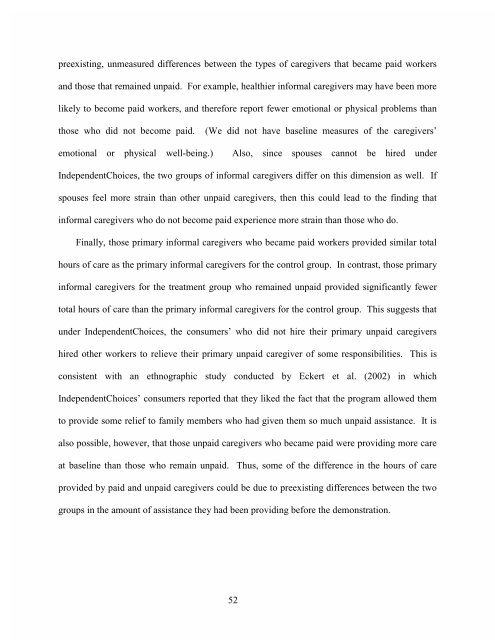The Experiences of Workers Hired Under Consumer Direction in ...
The Experiences of Workers Hired Under Consumer Direction in ...
The Experiences of Workers Hired Under Consumer Direction in ...
Create successful ePaper yourself
Turn your PDF publications into a flip-book with our unique Google optimized e-Paper software.
preexist<strong>in</strong>g, unmeasured differences between the types <strong>of</strong> caregivers that became paid workersand those that rema<strong>in</strong>ed unpaid. For example, healthier <strong>in</strong>formal caregivers may have been morelikely to become paid workers, and therefore report fewer emotional or physical problems thanthose who did not become paid. (We did not have basel<strong>in</strong>e measures <strong>of</strong> the caregivers’emotional or physical well-be<strong>in</strong>g.)Also, s<strong>in</strong>ce spouses cannot be hired underIndependentChoices, the two groups <strong>of</strong> <strong>in</strong>formal caregivers differ on this dimension as well. Ifspouses feel more stra<strong>in</strong> than other unpaid caregivers, then this could lead to the f<strong>in</strong>d<strong>in</strong>g that<strong>in</strong>formal caregivers who do not become paid experience more stra<strong>in</strong> than those who do.F<strong>in</strong>ally, those primary <strong>in</strong>formal caregivers who became paid workers provided similar totalhours <strong>of</strong> care as the primary <strong>in</strong>formal caregivers for the control group. In contrast, those primary<strong>in</strong>formal caregivers for the treatment group who rema<strong>in</strong>ed unpaid provided significantly fewertotal hours <strong>of</strong> care than the primary <strong>in</strong>formal caregivers for the control group. This suggests thatunder IndependentChoices, the consumers’ who did not hire their primary unpaid caregivershired other workers to relieve their primary unpaid caregiver <strong>of</strong> some responsibilities. This isconsistent with an ethnographic study conducted by Eckert et al. (2002) <strong>in</strong> whichIndependentChoices’ consumers reported that they liked the fact that the program allowed themto provide some relief to family members who had given them so much unpaid assistance. It isalso possible, however, that those unpaid caregivers who became paid were provid<strong>in</strong>g more careat basel<strong>in</strong>e than those who rema<strong>in</strong> unpaid. Thus, some <strong>of</strong> the difference <strong>in</strong> the hours <strong>of</strong> careprovided by paid and unpaid caregivers could be due to preexist<strong>in</strong>g differences between the twogroups <strong>in</strong> the amount <strong>of</strong> assistance they had been provid<strong>in</strong>g before the demonstration.52
















